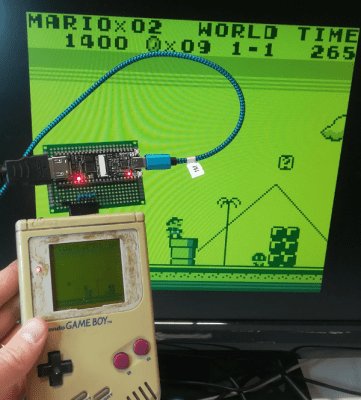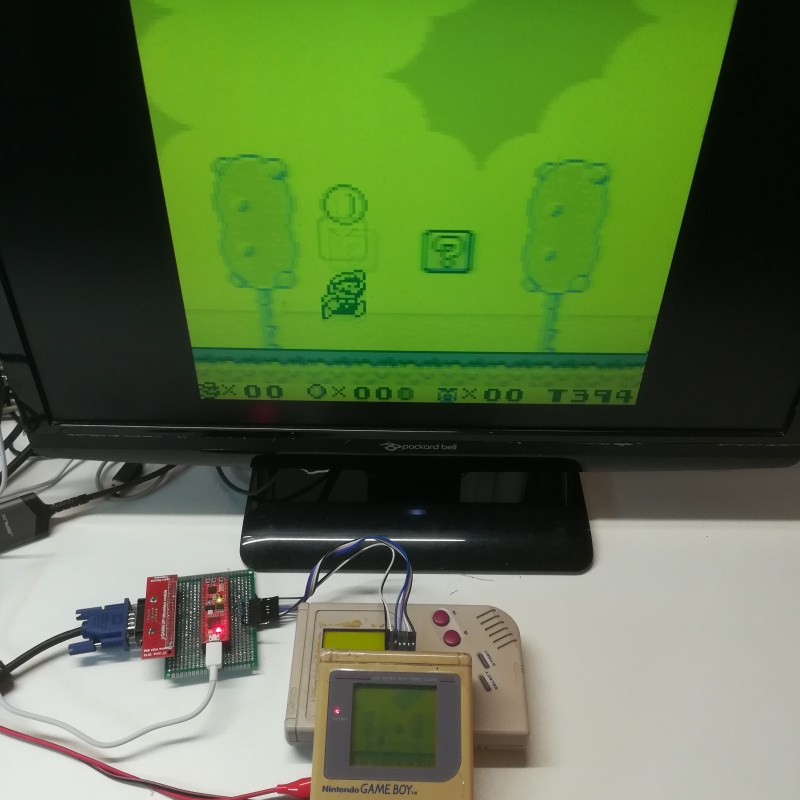The classic Game Boy remains a firm favorite in the realm of retrocomputing. Revolutionary as it was at the time, by today’s standards its display is rather primitive, with no backlight and a usable area measuring only 47 mm x 44 mm. [Martoni] figured out a way to solve this, by developing GbVGA and GbHdmi, two projects that enable the Game Boy to connect to an external monitor. This way, you can play Super Mario Land without straining your eyes, and we can also image potential uses for those who stream their gameplay online.
 Getting the image data out of the Game Boy is surprisingly straightforward, and has been done a few times before. Basically, the connection between the CPU and the LCD screen is a serial interface with a 4 MHz clock, two data lines and two sync lines. [Martoni] uses pin headers sticking out of the Game Boy’s plastic case to connect these to a small FPGA board. The board in question is a Fireant for the VGA version and a Tang Nano 4K for the HMDI model. In either case the FPGA reads out each frame from the Game Boy’s LCD interface and draws the extracted image onto the monitor, using the same four shades of green as used on the original screen.
Getting the image data out of the Game Boy is surprisingly straightforward, and has been done a few times before. Basically, the connection between the CPU and the LCD screen is a serial interface with a 4 MHz clock, two data lines and two sync lines. [Martoni] uses pin headers sticking out of the Game Boy’s plastic case to connect these to a small FPGA board. The board in question is a Fireant for the VGA version and a Tang Nano 4K for the HMDI model. In either case the FPGA reads out each frame from the Game Boy’s LCD interface and draws the extracted image onto the monitor, using the same four shades of green as used on the original screen.
[Martoni] states that the ultimate goal of these projects is to make a Switch-like docking station for the original Game Boy, which is definitely something we’re looking forward to. Although adding external monitors to the Game Boy is not entirely new, we like the simplicity of this implementation and the fact that anyone can improve upon it thanks to the full source code being available. Similar hacks have been performed on the newer Game Boy Pocket and Game Boy Advance as well.
















not sure if i would call the gameboy revolutionary if you compare it to the atari lynx, gamegear and turbografx-16 also released at that time. if you mean the sales, yes definitely.
since turbografx-16 is not a handheld compared to the other two, i guess you mean TurboExpress :)
but your comment stands, game boy was not revolutionary to the rest of them
It was revolutionary because the things that people thought mattered (color, screen size, CPU speed, backlight) turned out to be less important than battery life.
And price! It was 2/3 the price of the game gear, 1/2 the price of the Lynx, and 1/3 the price of the Turbo Express…and the batteries lasted about 5 times as long. Plus the game selection (launching in NA with tetris was genius) appealed to a larger audience.
>>> HMDI
Can’t tell if a typo or a way to avoid a certain group of trademark-lawsuit-happy lawyers. Either way, don’t change it, please, everyone ought to stop using the original name until the lawsuits cease.
Wait, there are lawsuits regarding people’s usage of the word HDMI?
HDMI is a registered trademark.
>If a trademark holder fails to police a mark and the mark falls subject to generification, the USPTO may deem the mark abandoned and subsequently strip the mark holder of her rights. As a result, trademark holders must constantly defend their trademark to ensure continued use.
generification = generic use of trademark. e.g. Xerox becomes every day usage to mean photocopy
Head Mounted Display Interface! Love it.
It kind of reminds me of the hdmyboy: http://www.hdmyboy.com/
Ho, that exactly my project ! But with a snes controller.
https://www.youtube.com/watch?v=gS8MB3lQmvk
now do the GBA
Yes, I bought two GBA to do the same. But harder than GameBoy, (more signals and more tiny).